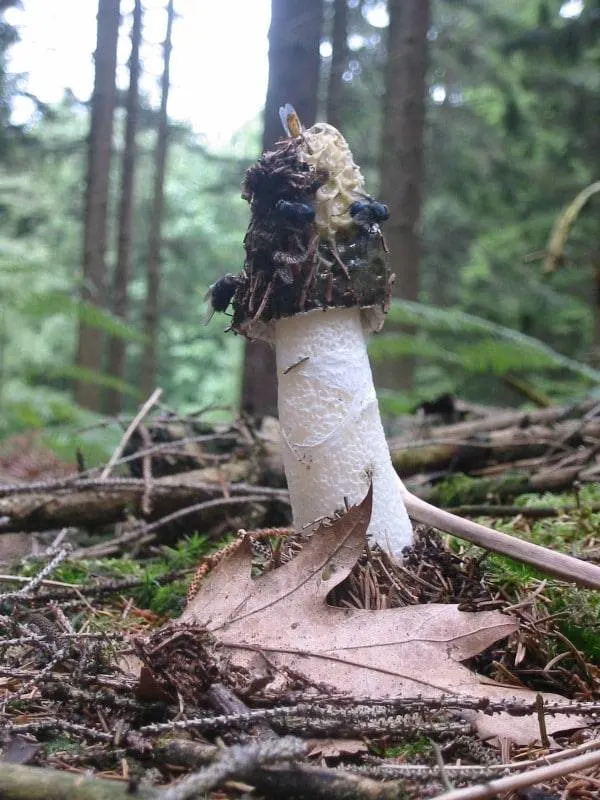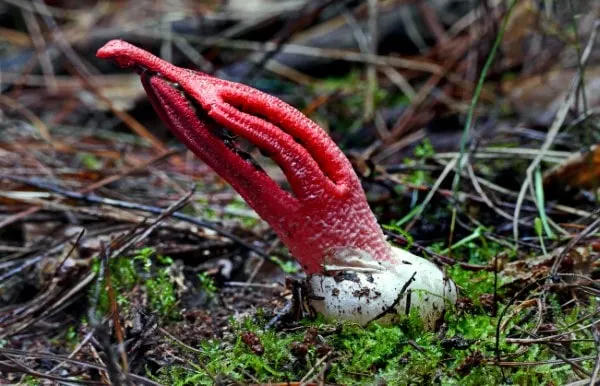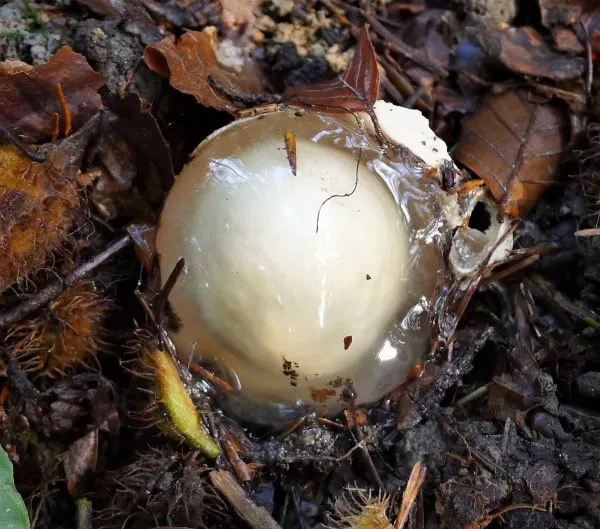Stinkhorn fungus comprises the Phallaceae and Clathraceae families and is called Phallus impudicus. This fungus is in the form of mushrooms that are often considered one of the most foul-smelling species as they emit a strong odor that resembles rotting meat.
The smell is emitted from the tips of the stalks, which are covered with a slimy substance that contains spores.
There are various types of stinkhorns belonging to this family. But the one you see most often is a thin and pale mushroom with a slimy head that looks like a phallus. Stinkhorns are one of the fastest-growing mushrooms globally, sometimes developing up to four to six inches per hour.
They can also generate enough force to break through asphalt. This fungus is not poisonous, but its foul smell is irritating. Therefore, people who have experienced stinkhorn fungus problems ask how to get rid of stinkhorn fungus. We have compiled this guide for them!

All About Stinkhorn Fungus
Stinkhorn mushrooms are a sort of fungus, sometimes also known as stinkhorn fungi, and can be found worldwide. Their habitats range from tropical rainforests to more temperate climates like those in Europe.
They comprise the Phallaceae family and the order Phallales with their seven species present naturally.
Unlike other mushrooms, stinkhorns don’t release their spores into the wind; rather, they sequester their spores away with the help of these insects.
Therefore, they can also be called Gasteromycetes (stomach fungi) or sequestrate fungi. Stinkhorn’s fungus attracts flies and other animals to disseminate their spores around through this smell.
Their strong smell can be likened to rotting dung or a dead and decaying animal. The smell is most noticeable if it is cut or broken.
Phallus ravenelli
It is the most common species of stinkhorn mushrooms having a phallic appearance which can be the reason for its taxonomic name, “Phallales.” It bears a sticky spore mass on the end of each stalk, known as the gleba receptaculum. This spore mass is responsible for the stinky odor.
The other six species of stinkhorn mushrooms have their distinct appearance. One has several appendages giving an octopus-like appearance.
Few species have a veil that looks like a skirt draping from the hollow stalk of the mushroom. Each of these species has a variety of colors ranging from white to beige to orange to black with black accents.
Clathrus archeri

Another species of stinkhorn fungus, known scientifically as Clathrus archeri often found growing in groups in fruit orchards or on lawns.
The fruiting body is a yellow stalk with a red-brown head with an unpleasant odor. Clathrus archeri is better known by its common names, stinkhorn and devil’s fingers.
These names come from the foul smell emitted when the mushroom is touched or spoiled by invertebrates like flies or slugs that crawl on it while it grows.
The spores emitted when the mushroom opens up after 3-4 days are carried away by the wind to new spots where they can grow and reproduce to form new mushrooms.
The Witch’s Egg

The stinkhorn initially appears in the ground in the egg form, looking like a freshly shelled hardboiled egg. Interestingly this mushroom is edible, and people mostly consume it in this egg stage when it hasn’t started emitting the foul smell. Kibby 2015 described its flavor as hazelnuts when eaten in its egg stage.
Want to know another interesting fact? These mushrooms are a delicacy in China and are used in various recipes. They are consumed raw as salad toppings or cooked in soups, sausages and pickles.
It would be common in the garden or woods from summer to late autumn. The eggs are also known as immature stinkhorns, which the gardeners commonly find while digging up the soil.
How To identify Stinkhorn Fungus
Stinkhorns are named for their foul odor emitted from the mature fruit body. The most common ways to identify Stinkhorn fungi are its white color, foul odor, and spore-producing gills attached to a stalk. Here are the ways to easily identify stinkhorn fungus:
- The smell of this toxic fungus indicates its presence. If you notice the smell of dead animals or rotting feces in your garden, then it’s time for you to be alert as this fungus has reached your garden.
- The unpleasant smell of stinkhorns attracts flies, so a large number of flies in your garden, especially around a mushroom, is an indication that your garden has a stinkhorn mushroom.
- To identify if the mushroom is stinkhorn, you must also correlate the environment, as this mushroom often requires a moist environment.
- All fungus sprouts out of woody substances such as dead and decaying trees. So, stinkhorns can also grow in many other types of terrain littered with leaves and decaying logs.
- You can easily identify a stinkhorn mushroom by its close examination. The description of the mushroom given above will help you in this respect. If the mushroom stands around 4–6 inches with a 1–4 cm slimy tip, it is a stinkhorn mushroom. You might notice a spongy texture of its cream-colored stem in some cases.
5 Solutions To Get Rid Of Stinkhorn Fungus
There are many ways to get rid of stinkhorn fungus naturally. Some people recommend using bleach to get rid of the stinkhorns because it is strong enough to kill them off.
However, this can be dangerous because it is harmful to humans and animals who might drink from the same water source later on. Other people recommend using vinegar or boiling water with salt, which will kill off the stinkhorn without harming anyone else.
Stinkhorn fungus might not look very harmful, but their strong smell can cause breathing difficulty or sometimes headaches. No one wants their beautiful garden to stink, so people look for ways to get rid of stinkhorn fungus. This section will discuss the different ways to prevent stinkhorn fungus.
1. Hand Picking
The cultural method of handpicking is the best to get rid of stinkhorn fungus. Wear protective gloves and root the mushrooms out of the soil with your hand.
2. Rake Them
The best way to get rid of stinkhorn fungus is to uproot it with the help of a rake. It will help you dig some soil beneath the roots taking up the stinkhorn’s spores out, inhibiting fungus growth nearby.
3. Environment Alteration
As discussed above, fungus grows in mulch, so you prevent their growth by removing the mulch. It would be best to replace it with other live mulch like cypress needles, straw, groundcovers, and pine.
4. Discard The Mushrooms
Put all the uprooted mushrooms in a plastic bag instead of mixing it with other yard waste. And discard this plastic bag properly away from the garden.
5. Use Chemical Agent
Spray environmentally approved fungal killer on the area to ensure the surrounding spores are dead. Leave that ground to receive plenty of slight to recover before replanting anything.
Conclusion
The conclusion of this article is to keep your garden free from the noxious stinkhorn fungus. Now that you know the symptoms and treatments of this fungus, you have the answer to how to get rid of stinkhorn fungus.
Keep your garden free from this fungus by following this guide and leaving a comment below if it was helpful!
